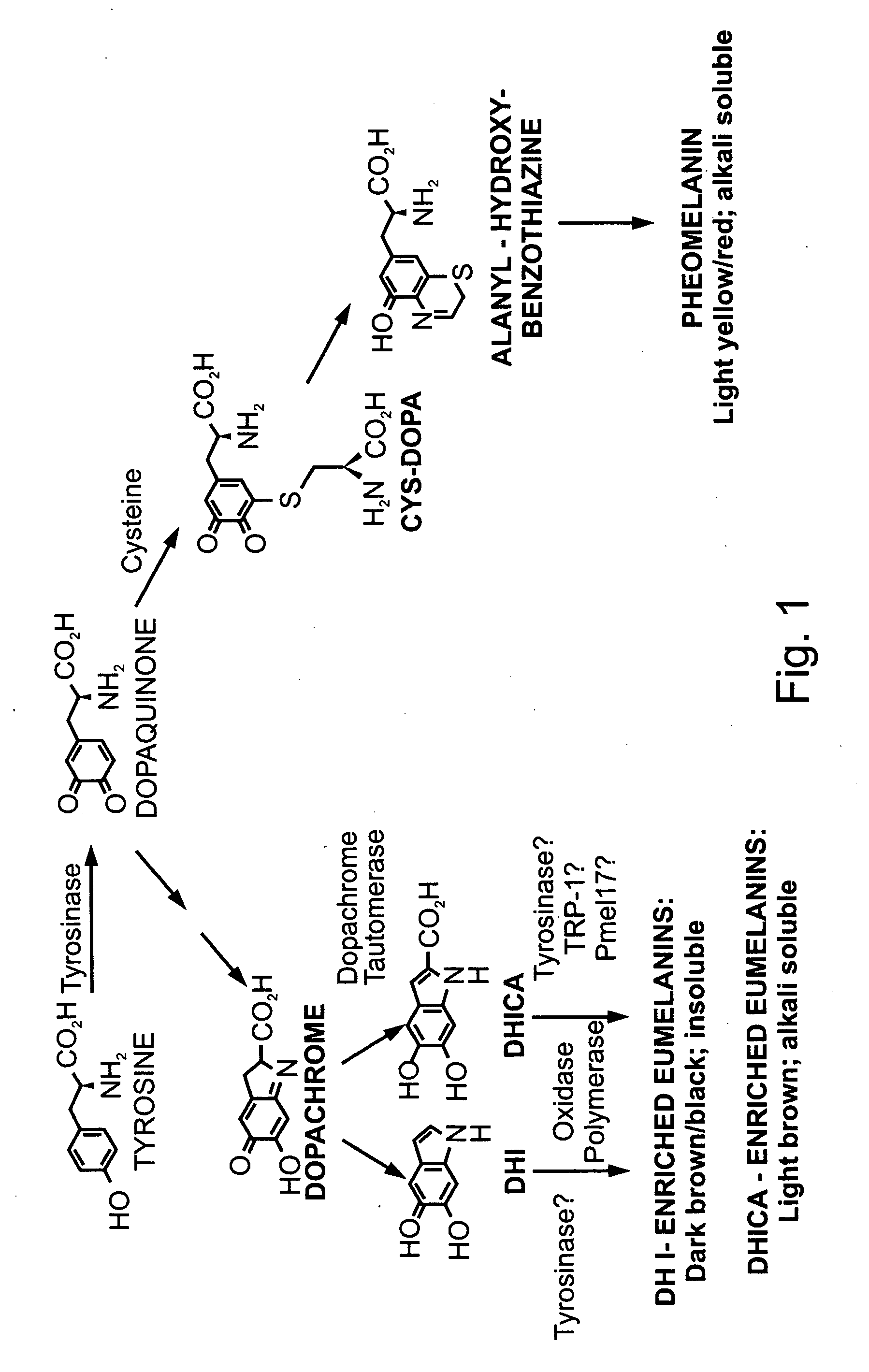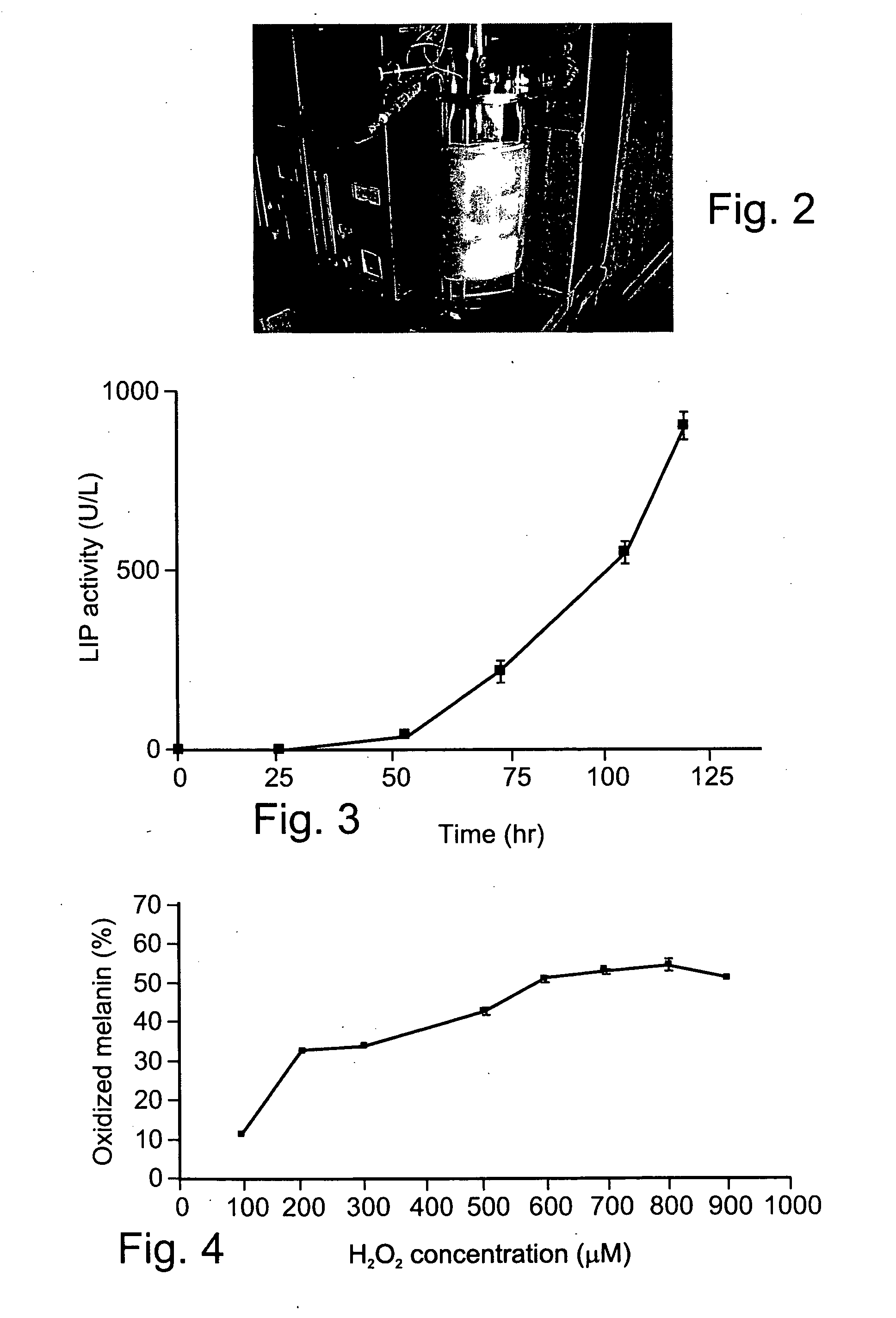Methods of producing lignin peroxidase and its use in skin and hair lightening
a technology of lignin peroxidase and lignin peroxidase, which is applied in the direction of biochemistry apparatus and processes, enzymes, cosmetics, etc., can solve the problems of unwanted skin and hair darkening and product efficiency is typically low, and achieve the effect of lightening a skin region or hair of a subj
- Summary
- Abstract
- Description
- Claims
- Application Information
AI Technical Summary
Benefits of technology
Problems solved by technology
Method used
Image
Examples
example 1
Purification of LIP from P. Chrysosporium
[0260] Preparation of highly purified LIP HI from P. chrysosporium—In order to purify LIP isoenzyme H1 from P. chrysosporium the fungus was grown in an STR fermentor (FIG. 2) as described in detail in the Methods section hereinabove. Initial LIP activity was detected after 48 hr of growth and significant increases in activity were detected when growth was maintained up to 120 hr (FIG. 3). For the purification of LIP isoenzyme H1 the extracellular fluid of the fungus was collected at peak LIP activity (120 hr.) The LIP isoenzyme H1 protein was then purified and its concentration was determined as described under Methods. Thus, using the abovementioned apparatus and conditions, LIP can be reliably produced and its H1 isoenzyme can be purified by HPLC.
example 2
Optimization of Melanin in an Aqueous Phase Oxidation Using Purified LIP
[0261] In order to optimize the conditions needed for melanin oxidation by LIP, optimal concentration of each of the critical components of the oxidation reaction was determined independently.
[0262] LIP oxidization of melanin in an aqueous phase, is a function of hydrogen peroxide concentration—Oxidation of melanin by LIP in an aqueous phase was first tested for correlation to hydrogen peroxide concentrations. A constant concentration of melanin (70.5 μg / ml) was oxidized by 0.48 μM of purified LIP H1 in the presence of 1.5 mM veratryl alcohol and with increasing concentrations of hydrogen peroxide. Degree of oxidation was determined by measuring melanin's absorbance at 460 nm, before the addition of hydrogen peroxide and 160 sec after that, and was calculated in percentages. Generally, the oxidation of melanin increased with increasing concentrations of hydrogen peroxide up to a plateau that was obtained at 70...
example 3
Oxidation of Melanin Using LIP in a Cream Formulation
[0265] To further substantiate the ability of LIP isoenzyme H1 to oxidize melanin and as an intermediate step towards skin lightening in vivo, the LIP activity was tested in a cream formulation on melanin solubilized in an aqueous phase.
[0266] Melanin in an aqueous phase is oxidized by LIP in a cream formulation—Two types of cream were prepared: the enzyme cream comprising the LIP isoenzyme H1 fraction (25 units / gr cream).and veratryl alcohol (6 mmole / Kg cream), and the activator cream comprising hydrogen peroxide (3.52 mmole / Kg cream). For determination of LIP activity in a cream formulation the enzyme cream (0.3. gr) was first mixed with melanin (140 μg / ml) and a grayish black color was observed (FIG. 8a). When the activator cream (0.3 gr) was added to the enzyme cream already containing melanin, the color was immediately changed to beige (FIG. 8b). These results demonstrate that LIP in a cream formulation is highly efficient ...
PUM
| Property | Measurement | Unit |
|---|---|---|
| temperature | aaaaa | aaaaa |
| time period | aaaaa | aaaaa |
| time period | aaaaa | aaaaa |
Abstract
Description
Claims
Application Information
 Login to View More
Login to View More - R&D
- Intellectual Property
- Life Sciences
- Materials
- Tech Scout
- Unparalleled Data Quality
- Higher Quality Content
- 60% Fewer Hallucinations
Browse by: Latest US Patents, China's latest patents, Technical Efficacy Thesaurus, Application Domain, Technology Topic, Popular Technical Reports.
© 2025 PatSnap. All rights reserved.Legal|Privacy policy|Modern Slavery Act Transparency Statement|Sitemap|About US| Contact US: help@patsnap.com



